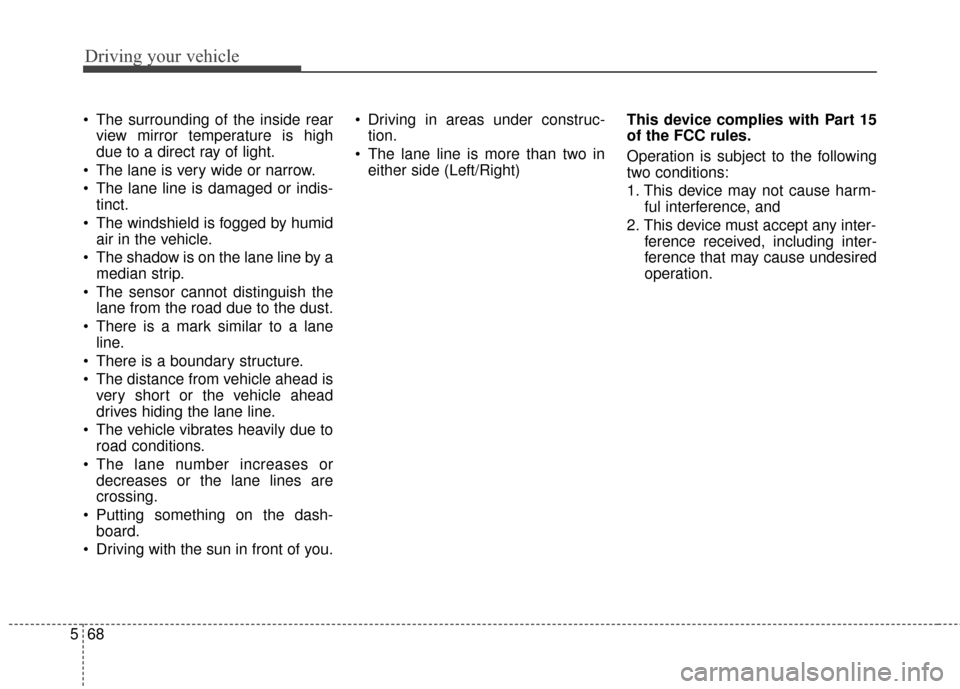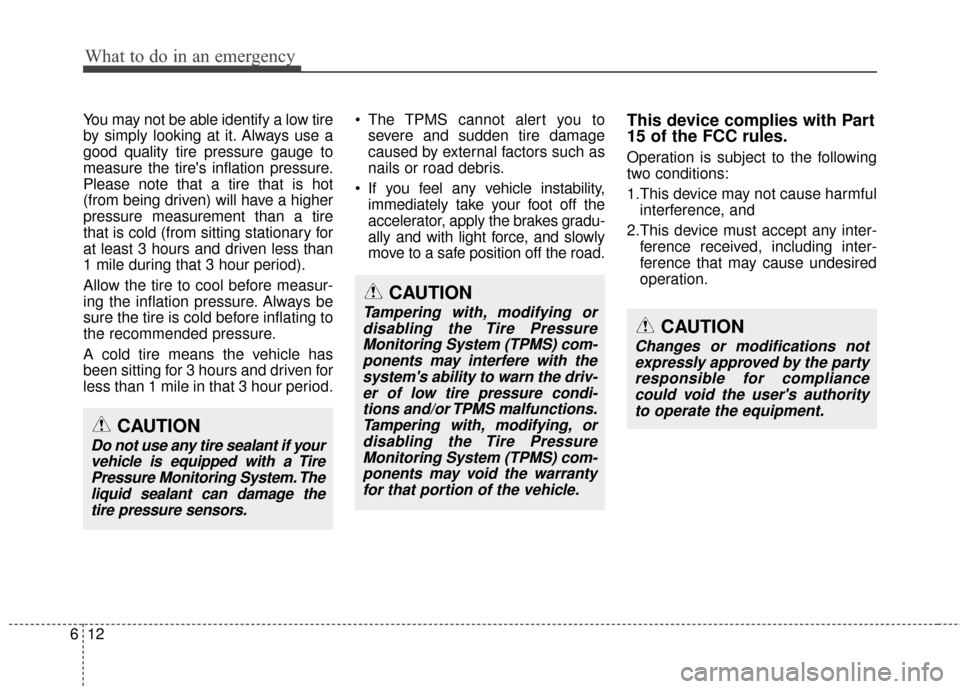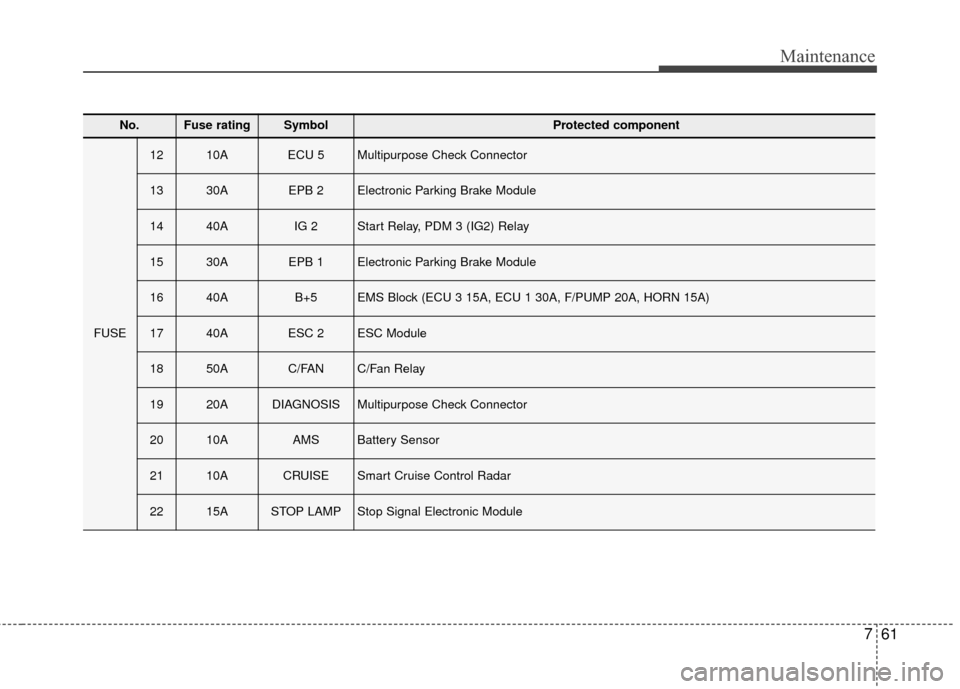2016 Hyundai Azera sensor
[x] Cancel search: sensorPage 373 of 521

Driving your vehicle
68
5
The surrounding of the inside rear
view mirror temperature is high
due to a direct ray of light.
The lane is very wide or narrow.
The lane line is damaged or indis- tinct.
The windshield is fogged by humid air in the vehicle.
The shadow is on the lane line by a median strip.
The sensor cannot distinguish the lane from the road due to the dust.
There is a mark similar to a lane line.
There is a boundary structure.
The distance from vehicle ahead is very short or the vehicle ahead
drives hiding the lane line.
The vehicle vibrates heavily due to road conditions.
The lane number increases or decreases or the lane lines are
crossing.
Putting something on the dash- board.
Driving with the sun in front of you. Driving in areas under construc-
tion.
The lane line is more than two in either side (Left/Right) This device complies with Part 15
of the FCC rules.
Operation is subject to the following
two conditions:
1. This device may not cause harm-
ful interference, and
2. This device must accept any inter- ference received, including inter-
ference that may cause undesired
operation.
Page 402 of 521

69
What to do in an emergency
TPMS malfunctions may occur for a
variety of reasons, including the
installation of replacement or alter-
nate tires or wheels on the vehicle
that prevent the TPMS from function-
ing properly. Always check the TPMS
malfunction telltale after replacing
one or more tires or wheels on your
vehicle to ensure that the replace-
ment or alternate tires and wheels
allow the TPMS to continue to func-
tion properly.
✽ ✽NOTICE
Take your vehicle to the nearest
authorized HYUNDAI dealer and
have the system checked if any of
the below happens:
1.The low tire pressure telltale/
TPMS malfunction indicator do
not illuminate for 3 seconds when
the ignition switch is turned to the
ON position or engine is running.
2. The TPMS malfunction indicator remains illuminated after blinking
for approximately 1 minute.
3. The Low tire pressure position telltale remains illuminated.
Low tire pressure
telltale
Low tire pressure
position telltale
When the tire pressure monitoring
system warning indicators are illumi-
nated, one or more of your tires is
significantly under-inflated. The low
tire pressure position telltale light will
indicate which tire is significantly
under-inflated by illuminating the cor-
responding position light.
If either telltale illuminates, immedi-
ately reduce your speed, avoid hard
cornering and anticipate increased
stopping distances. You should stop
and check your tires as soon as pos-
sible. Inflate the tires to the proper
pressure as indicated on the vehicle’s
placard or tire inflation pressure label
located on the driver’s side center pil-
lar outer panel. If you cannot reach a
service station or if the tire cannot
hold the newly added air, replace the
low pressure tire with a spare tire. After restarting with the spare tire, the
TPMS malfunction indicator and low
tire pressure position telltale light will
remain on about 20 minutes of con-
tinuous driving, then the TPMS mal-
function indicator will blink for approx-
imately 1 minute but the low tire pres-
sure position telltale light will turn off.
✽ ✽
NOTICE
The compact spare tire is not
equipped with a tire pressure sensor.
Page 403 of 521

What to do in an emergency
10
6
TPMS (Tire Pressure
Monitoring System)
malfunction indicator
The TPMS malfunction indicator will
illuminate after it blinks for approxi-
mately one minute when there is a
problem with the Tire Pressure
Monitoring System. If the system is
able to correctly detect an underinfla-
tion warning at the same time as sys-
tem failure then the TPMS malfunction
indicator remains illuminated after
blinking for approximately 1 minute and
the low tire pressure position telltale
will illuminate. For example, if Front Left
sensor fails, the TPMS malfunction
indicator remains illuminated after
blinking for approximately 1 minute, but
if the Front Right, Rear Left, or Rear
Right tire is under-inflated, the low tire
pressure position telltales may illumi-
nate together with the TPMS malfunc-
tion indicator. Have the system
checked by an authorized HYUNDAI
dealer as soon as possible to deter-
mine the cause of the problem.
WARNING - Low pressure
damage
Do not drive on low pressure
tires. Significantly low tire pres-
sure can cause the tires to over-
heat and fail making the vehicle
unstable resulting in increased
braking distances and a loss of
vehicle control.CAUTION
In winter or cold weather, the low tire pressure telltale may beilluminated if the tire pressurewas adjusted to the recom-mended tire inflation pressurein warm weather. It does notmean your TPMS is malfunction-ing because the decreased tem-perature leads to a proportionallowering of tire pressure.
When you drive your vehiclefrom a warm area to a cold areaor from a cold area to a warmarea, or the outside temperatureis greatly higher or lower, youshould check the tire inflationpressure and adjust the tires tothe recommended tire inflationpressure.
Page 404 of 521

611
What to do in an emergency
The TPMS malfunction indicatormay blink for approximately 1
minute and then remain continu-
ously illuminated if the vehicle is
moving around electric power sup-
ply cables or radios transmitter
such as at police stations, govern-
ment and public offices, broadcast-
ing stations, military installations,
airports, or transmitting towers,
etc. This can interfere with normal
operation of the Tire Pressure
Monitoring System (TPMS).
The TPMS malfunction indicator may blink for approximately 1
minute and then remain continu-
ously illuminated if snow chains are
used or some separate electronic
devices such as notebook comput-
er, mobile charger, remote starter
or navigation etc., are used in the
vehicle. This can interfere with nor-
mal operation of the Tire Pressure
Monitoring System (TPMS).Changing a tire with TPMS
If you have a flat tire, the low Tire
Pressure and Position telltales will
come on. Have the flat tire repaired
by an authorized HYUNDAI dealer
as soon as possible or replace the
flat tire with the spare tire. Each wheel is equipped with a tire
pressure sensor mounted inside the
tire behind the valve stem. You must
use TPMS specific wheels. It is rec-
ommended that you always have your
tires serviced by an authorized
HYUNDAI dealer as soon as possible.
After you replace the low pressure
tire with the spare tire, the TPMS
malfunction indicator may blink for
approximately 1 minute and then
remain continuously illuminated
because the TPMS sensor is not
mounted on the spare wheel.
Once the low pressure tire is reinflat-
ed to the recommended pressure
and installed on the vehicle is initiat-
ed by an authorized HYUNDAI deal-
er, the TPMS malfunction indicator
and the low tire pressure and posi-
tion telltales will turn off within a few
minutes of driving.
If the indicators do not go off after a
few minutes of driving, please visit
an authorized HYUNDAI dealer.
CAUTION
Never use a puncture-repairing
agent not approved by HYUNDAIto repair and/or inflate a lowpressure tire. The tire sealantnot approved by HYUNDAI maydamage the tire pressure sen-sor. The sealant on the tire pres-sure sensor and wheel shall beeliminated when you replace thetire with a new one.
Page 405 of 521

What to do in an emergency
12
6
You may not be able identify a low tire
by simply looking at it. Always use a
good quality tire pressure gauge to
measure the tire's inflation pressure.
Please note that a tire that is hot
(from being driven) will have a higher
pressure measurement than a tire
that is cold (from sitting stationary for
at least 3 hours and driven less than
1 mile during that 3 hour period).
Allow the tire to cool before measur-
ing the inflation pressure. Always be
sure the tire is cold before inflating to
the recommended pressure.
A cold tire means the vehicle has
been sitting for 3 hours and driven for
less than 1 mile in that 3 hour period. The TPMS cannot alert you to
severe and sudden tire damage
caused by external factors such as
nails or road debris.
If you feel any vehicle instability, immediately take your foot off the
accelerator, apply the brakes gradu-
ally and with light force, and slowly
move to a safe position off the road.This device complies with Part
15 of the FCC rules.
Operation is subject to the following
two conditions:
1.This device may not cause harmfulinterference, and
2.This device must accept any inter- ference received, including inter-
ference that may cause undesired
operation.
CAUTION
Do not use any tire sealant if yourvehicle is equipped with a TirePressure Monitoring System. Theliquid sealant can damage thetire pressure sensors.
CAUTION
Tampering with, modifying ordisabling the Tire PressureMonitoring System (TPMS) com-ponents may interfere with thesystem's ability to warn the driv-er of low tire pressure condi-tions and/or TPMS malfunctions.Tampering with, modifying, ordisabling the Tire PressureMonitoring System (TPMS) com-ponents may void the warrantyfor that portion of the vehicle.
CAUTION
Changes or modifications notexpressly approved by the partyresponsible for compliancecould void the user's authorityto operate the equipment.
Page 473 of 521

Maintenance
56
7
Instrument panel (Driver’s side fuse panel)
No.Fuse ratingSymbol Protected component
17.5AIMMOSmart Key Control Module
27.5A A/BAG INDInstrument Cluster
320ASPARE-
410AAUDIOAMP, Smart Key Control Module, Telematics Unit,E/R Junction Block (Power Outlet Relay),
A/V & Navigation Head Unit,Front Monitor (Audio/Navigation), Audio, A/C Control Module
57.5AMODULE 2ESC Control Module, Rear Seat Warmer LH/RH,
Console Switch, A/C Control Module, Rear Power Window Switch LH/RH,
Driver IMS Module, Rear Parking Assist Sensor LH/RH/LH(Center)/RH(Center)
610AMODULE 1
Driver Power Seat Switch, Driver/Passenger Seat Warmer Module, Driver/Passenger Door Module,
Stop Lamp Switch, Crash Pad Switch, Driver/Passenger CCS Control Module,
Steering Tilt & Telescope Module, Instrument Cluster, Blind Spot Detection Radar LH/RH,
Multifunction Switch, Forward Collision Warning Unit, Lane Departure Warning Unit,
Electro Chromic Mirror, ATM Lever Indicator, Tire Pressure Monitoring Module, Telematics Unit
710AHTD MIRRDriver/Passenger Power Outside Mirror, A/C Control Module
87.5AMDPSMDPS Unit
920AC/LIGHTERCenter Tray Outlet
1015AA/BAGSRS Control Module, Passenger Occupant Detection Sensor, A/C Control Module
Page 474 of 521

757
Maintenance
No.Fuse ratingSymbol Protected component
117.5AMODULE 3Smart Key Control Module, Rear Seat Warmer LH/RH
127.5AA/CONA/C Control Module, E/R Junction Block (Blower Relay), Driver/Passenger Seat Warmer Module,
Active Incar Sensor, Driver/Passenger CCS Control Module
1315AIG1 2Steering Wheel Heater
1420AIG1 1E/R Junction Block (ECU 5 10A, ECU 4 10A)
1510AMEMORY 1Driver Power Seat Switch, Data Link Connector, A/C Control Module, Driver/Passenger Door Module,
Instrument Cluster, Tire Pressure Monitoring Module, Auto Light & Photo Sensor
1610AINTERIOR LAMP
Rear Door Lamp LH/RH, MAP Lamp, Garnish Lamp LH/RH, Driver/Passenger Door Mood Lamp,
Driver/Passenger Door Lamp, Driver/Passenger Foot Lamp, Driver/Passenger Door Scuff Lamp,
Rear Door Mood Lamp LH/RH, Vanity Lamp Switch LH/RH, Rear Door Scuff Lamp LH/RH,
Trunk Room Lamp, Rear Personal Lamp Center/LH/RH
1725AWIPERWiper Motor, E/R Junction Block (Washer Relay, Wiper (LO) Relay, Wiper (HI) Relay)
1810ASTOP LAMPSmart Key Control Module, Stop Lamp Switch, Start Stop Button Switch
197.5AMEMORY 2RF Receiver
2010AMULTI MEDIAFront Monitor (Audio/Navigation), A/V & Navigation Head Unit, Telematics Unit, Audio
217.5ASTARTTransaxle Range Switch, PCM
Page 478 of 521

761
Maintenance
No.Fuse ratingSymbol Protected component
FUSE
1210AECU 5Multipurpose Check Connector
1330AEPB 2Electronic Parking Brake Module
1440AIG 2Start Relay, PDM 3 (IG2) Relay
1530AEPB 1Electronic Parking Brake Module
1640AB+5EMS Block (ECU 3 15A, ECU 1 30A, F/PUMP 20A, HORN 15A)
1740AESC 2ESC Module
1850AC/FANC/Fan Relay
1920ADIAGNOSISMultipurpose Check Connector
2010AAMSBattery Sensor
2110ACRUISESmart Cruise Control Radar
2215ASTOP LAMPStop Signal Electronic Module